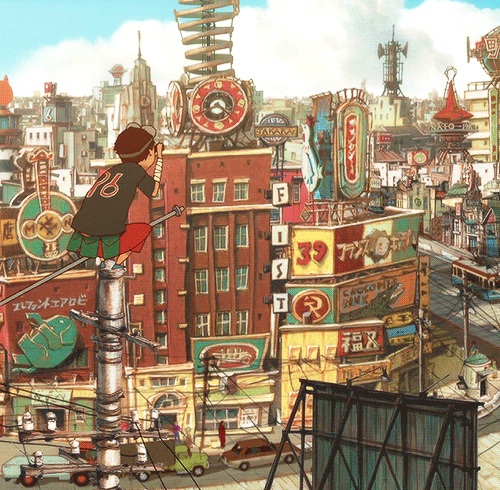**Reposted from my Tumblr, elizas-writing, as of December 6th, 2018**
From the same mangaka, Taiyo Matsumoto, who brought us Ping Pong, we now have Tekkonkinkreet, the 2006 film adaptation of his manga of the same name. Bit of a personal silly moment, I honestly assumed this film was animated by the same director as Ping Pong: The Animation and The Tatami Galaxy because the styles were so similar. Turns out, I was completely wrong. Not only does this film have a different director, but he’s also American, making Michael Arias the first non-Japanese director of an anime film.
Let’s see how Arias fares in his directorial debut.

Kuro (Black) and Shiro (White) are two orphan kids living as street thugs in Treasure Town. Kuro spends most of his time pick-pocketing and maintaining reputation as a Cats gang member and always itching to fight. Meanwhile, Shiro daydreams of a life outside of Treasure Town and is often off in his own little world. Despite their opposing personalities, they balance each other out for emotional survival. But that’ll soon be disrupted with plans to turn Treasure Town into an amusement park and drive out the rampant delinquent children. And Kuro takes it upon himself to fight anyone to drive out construction while protecting Shiro from harm’s way.
It’s interesting to see a different director’s take on Matsumoto’s surreal art style. Not a single detail goes untouched in the backgrounds, and it’s incredibly colorful even with the horrible conditions of Treasure Town. In contrast, the character designs are an odd combination of sketchy realism and minimalism which focuses more on their expressions and movements than detail. Much like Ping Pong, the style is an acquired taste that not everyone is going to like, but I think it’s much smoother here, and you can tell the animators had a lot more to work with in the style.
Kuro and Shiro make this film with the focus on how they balance each other out like Yin and Yang. Shelter and food seems easily obtainable to survive, but what matters more is maintaining connections and sanity, especially with kids this young who have no one else in the world. Just as Kuro protects Shiro from dangerous yakuza, Shiro’s optimism keeps Kuro grounded so he fights with a purpose instead of just mindlessly picking fights. Their relationship has a bit of obvious symbolism, but the animation and voice work do amazingly well to show their reliance on each other.
It’s also fascinating to see a character like Shiro with heavy autistic coding where no one’s trying to fix him. I’m not entirely sure how to feel about this depiction since it focuses a lot on making him childish, but since he’s orphaned and homeless, you can argue that may be the point since he’s never had parents, and Kuro can’t be a parent for him. What is concrete is that his optimism has this likable charm to it where it warms everyone’s hearts, even though the reality of their environment says otherwise. And everyone is so accepting that it’s just how Shiro sees the world. They may not understand all of his isms, but hey, can you blame a kid for wishing for something better than what he has?
However, when it starts introducing a bunch of side characters, that’s where the focus gets wonky. The film took a bunch of plot threads from the manga and jammed it all into a bit of a compilation film, which wouldn’t be a bad idea if the stories flowed much better or were wrapped up neater. There’s a bunch of side plots with yakuza members who are back and forth between the amusement park construction, but they seem to have nothing to do with the central conflict with Kuro and Shiro, and sometimes it seems like a totally different movie. If this was made into a TV series, there would be enough time to flesh the side characters and main villain, but as is, they’re just their to boost up the worldbuilding and that’s about it. And the side stories really drag after a while. I wasn’t even halfway through, and I got antsy wondering how much was left of this movie.
There’s also bits of the supernatural which seems out of place like how Kuro and Shiro can fly and this trippy encounter with a figure known as Minotaur at the end where you can’t tell if it’s a reality or a dream, and it’s never properly addressed if it’s meant to be metaphorical or literal. When 99 percent of the film is grounded in realism, it’s really distracting to throw in these supernatural elements without explanation on where they came from. Sure, it makes for fun fight scenes and bizarre imagery, but it still feels out of place.
I know this review is all over the place, but this movie kinda felt that way too. I didn’t hate it; I still love the main relationship of Kuro and Shiro and the fluid and detailed animation. While the symbolism is in your face, it’s interesting to dive into the kids’ psyches and speculate on their pasts. But when it’s cramped with a bunch of unnecessary and underdeveloped parts, it starts to weigh the film down. However, it’s still worth recommending if you’re someone looking for an anime film more out of the norm.